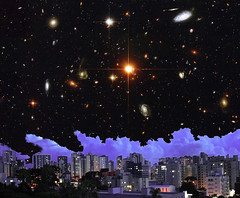
 Image via WikipediaThe reason today's cosmetologist and scientist think when they are looking at distant stars like GRB090423 and assume that the dying stages we are observing happened 13 billion years ago is that they have forgotten that "light years" is a measurement of distance, not time.
Image via WikipediaThe reason today's cosmetologist and scientist think when they are looking at distant stars like GRB090423 and assume that the dying stages we are observing happened 13 billion years ago is that they have forgotten that "light years" is a measurement of distance, not time.A light year is around 6 trillion miles so it was decided to use the time it takes light to travel through space to measure distances in space making any calculations easier.
This fact seems to have been lost in today's world, and calculations and incorrect assumptions are being made by thinking we can "time travel" because we measure universal distance by "light years."
The light from the stars are released at source and it does travel through space, but it leaves the star behind and travels as rays.
There are many stars in the universe that cannot be seen from earth no matter how powerful the telescope is as they are too far away from us or in some cases hidden by the clutter around our planet.
When we ventured out past our atmosphere and into space we began to discover more stars and galaxies simply because we could see farther, not because the images of stars and galaxies were finally reaching us.
The more we learn about the universe and the more powerful our methods of reaching for the stars becomes, the farther we see out into space through the miles.
It is our methods that enable us to do this, not the fact that these images or sources of light are reaching us as our scientists and cosmetologist would have us believe.
Take a light bulb e.g., when it is switch on the light leaves the source and spreads around the room but the bulb stays where it is.
We look at the source of light through the beam it sends across the room, and across the distance the light source is from us.
Although the light reaches our faces the source stays where it is and in the same form it was in when the light left it. It does not take the source of the light with it.
It is in the same principle that light reacts in space.
The stars we see in space release their light which then travels a distance that is miles not time, leaves the star in the form it was and by the time it reaches us the form of that star might have changed. If we had been around when the light left the star we would have been able to observe the star in that form, but we can only observe it as it is now.
The fact that it takes various times for light to reach us from different parts of space denotes the distance in miles of that event we are studying, not the amount of years ago it happened, hence the fact that what we are seeing out there now is happening now.
The image of new stars, dying or forming is not suddenly emerging to us by any of us travelling through time, but by our modern methods of covering the miles between us.
We are waiting for Beetlejuice (or Betelgeuse as it is also known) which is 520-1400 light years away from earth to become a supernova, and we are told that GRB090423 is in it's dying throes 13 billion years away from us.
We watch and observe stars dying and galaxies forming light years from us that are much closer than GRB090423, so if they were actual years away from us instead of miles we would be able to go back 9 billion years and see GRB090423 as it was then, move through time and observe stars of interest at various stages of their lives.
If the light from these stars traveled as the scientist would have us believe there would be images of the same star in different place in the universe as all the stars are moving great distances as time goes past in an ever expanding universe.
We would be able to travel in time and see the galaxies that are forming actually formed but we are not looking back through time when we look into space we are looking across the miles.
Instead of waiting for Beetlejuice to become a supernova we could go forward in time to see when it changed.
Beetlejuice is much closer to us than GRB090423 and if it was the case that the image we see of it now happened between 520-1400 light years ago, we could go farther back and see it during its life as a bright star, or even farther back and observe its birth, but light years are only miles, mans conception of distance in space, not actual time.
Time travel and seeing the stars as they were, we cannot, but we can, through modern methods travel through the miles that separates us from the stars and observe them as they are now.
Poor old GRB090423 is dying before our very eyes, and if we are around when Beetlejuice becomes a supernova we will be able to observe it as it happens.




![Reblog this post [with Zemanta]](http://img.zemanta.com/reblog_e.png?x-id=38cd19d2-e1f4-4794-a31e-1dc8b37b2add)

![Reblog this post [with Zemanta]](http://img.zemanta.com/reblog_e.png?x-id=f9129283-856a-42fd-b229-882dc820d316)

![Reblog this post [with Zemanta]](http://img.zemanta.com/reblog_e.png?x-id=6310ab80-a5f8-4a63-adac-f7a8112d6758)



![Reblog this post [with Zemanta]](http://img.zemanta.com/reblog_e.png?x-id=d04ceba3-6012-4f6b-80e2-3b31e07bea0c)
